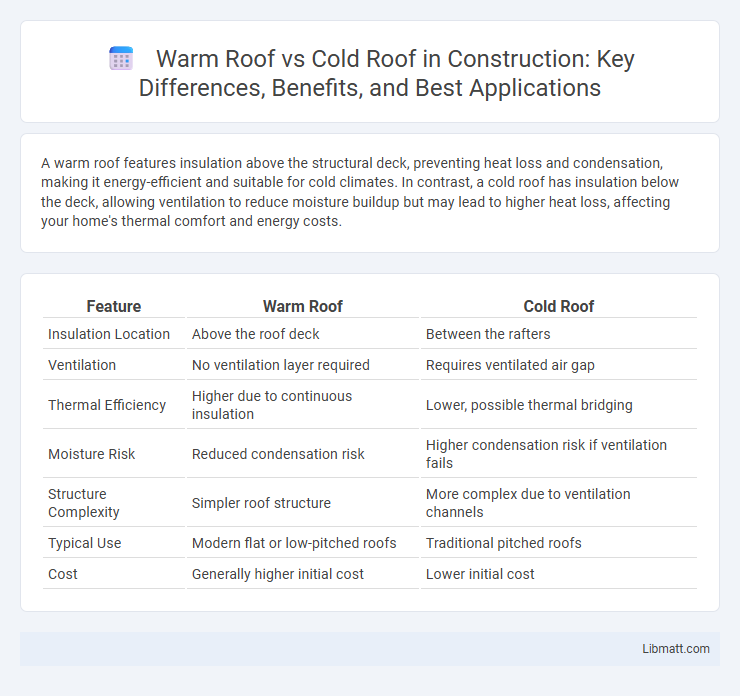A warm roof features insulation above the structural deck, preventing heat loss and condensation, making it energy-efficient and suitable for cold climates. In contrast, a cold roof has insulation below the deck, allowing ventilation to reduce moisture buildup but may lead to higher heat loss, affecting your home's thermal comfort and energy costs.
Table of Comparison
| Feature | Warm Roof | Cold Roof |
|---|---|---|
| Insulation Location | Above the roof deck | Between the rafters |
| Ventilation | No ventilation layer required | Requires ventilated air gap |
| Thermal Efficiency | Higher due to continuous insulation | Lower, possible thermal bridging |
| Moisture Risk | Reduced condensation risk | Higher condensation risk if ventilation fails |
| Structure Complexity | Simpler roof structure | More complex due to ventilation channels |
| Typical Use | Modern flat or low-pitched roofs | Traditional pitched roofs |
| Cost | Generally higher initial cost | Lower initial cost |
Understanding Warm Roof and Cold Roof Systems
Warm roof systems feature insulation above the structural deck, creating a sealed, energy-efficient barrier that minimizes thermal bridging and condensation risks. Cold roof systems place insulation below the structural deck, allowing ventilation that prevents moisture buildup but can lead to heat loss during colder months. Choosing between warm and cold roof systems depends on climate, building use, and desired energy performance outcomes.
Key Differences Between Warm and Cold Roof Designs
Warm roof designs feature insulation placed above the structural deck, preventing condensation by maintaining the roof surface temperature above the dew point. Cold roofs incorporate ventilation beneath the insulation, allowing airflow to remove moisture and regulate temperature but risk cold spots that can lead to condensation. The primary difference lies in insulation placement and ventilation strategy, affecting thermal efficiency and moisture control.
How Warm Roofs Work: Structure and Benefits
Warm roofs feature insulation installed directly above the structural deck, keeping the entire roof assembly within the conditioned space, which prevents condensation and enhances energy efficiency. The continuous insulation layer supports a longer lifespan for roofing materials by reducing thermal stress and moisture-related damage. Your building benefits from improved thermal performance and comfort, making warm roofs an effective solution for sustainable construction.
How Cold Roofs Function: Structure and Drawbacks
Cold roofs function by allowing ventilation between the insulation layer and the roofing material, preventing heat buildup and moisture accumulation within the roof space. The ventilated cavity maintains a lower temperature, reducing the risk of condensation but often resulting in less effective insulation and higher energy costs compared to warm roofs. Common drawbacks include increased risk of ice dam formation and thermal bridging, which can lead to heat loss and structural damage over time.
Insulation Placement: Warm Roof vs Cold Roof
In a warm roof, insulation is placed above the structural deck, creating a continuous layer that minimizes thermal bridging and keeps the roof structure warm. In contrast, a cold roof has insulation installed between the rafters below the structural deck, leaving the roof deck exposed to external temperature variations. Your choice of insulation placement directly affects energy efficiency, condensation risk, and overall roof performance.
Energy Efficiency Comparison: Warm Roof vs Cold Roof
Warm roofs provide superior energy efficiency by insulating directly above the structural deck, minimizing heat loss and reducing thermal bridging. Cold roofs, with insulation placed between or below rafters, often allow colder air circulation in the roof cavity, leading to greater heat loss and potential condensation issues. Studies show warm roof assemblies can reduce heating demand by up to 15% compared to cold roof designs, making them more effective for energy conservation in residential and commercial buildings.
Moisture and Condensation Control in Roof Systems
Warm roof systems minimize moisture and condensation by placing insulation above the roof deck, maintaining the deck temperature above dew point and preventing internal condensation. Cold roof systems risk condensation as the deck cools below dew point, allowing moisture to accumulate and potentially cause structural damage or mold growth. Effective vapor barriers and ventilation are essential in cold roofs to mitigate moisture buildup, while warm roofs rely on continuous insulation for superior condensation control.
Installation Process: Warm Roof vs Cold Roof
The installation process of a warm roof involves placing insulation above the structural deck, followed by a waterproof membrane, which simplifies work during refurbishments and reduces thermal bridging. In contrast, a cold roof requires installing insulation between or below the rafters, necessitating a ventilated cavity to prevent condensation, making the process more complex and time-consuming. Understanding these differences ensures your roofing project addresses thermal efficiency and moisture control effectively.
Cost Considerations: Warm Roof vs Cold Roof
Warm roofs typically incur higher upfront costs due to the need for enhanced insulation materials placed above the roof deck, increasing both material and labor expenses. Cold roofs generally offer lower initial installation costs by incorporating ventilation spaces beneath the insulation, reducing insulation material requirements. Long-term maintenance costs may be lower for warm roofs as they prevent condensation and related damage, whereas cold roofs may require more frequent inspections and repairs to address moisture issues.
Choosing the Right Roof System for Your Building
Selecting the right roof system for your building depends on factors like insulation requirements, climate, and structural design. A warm roof insulates above the roof deck, reducing heat loss and minimizing condensation, making it ideal for colder climates. In contrast, a cold roof features insulation below the roof deck, allowing ventilation, which suits buildings where moisture control is critical.
Warm roof vs cold roof Infographic

 libmatt.com
libmatt.com